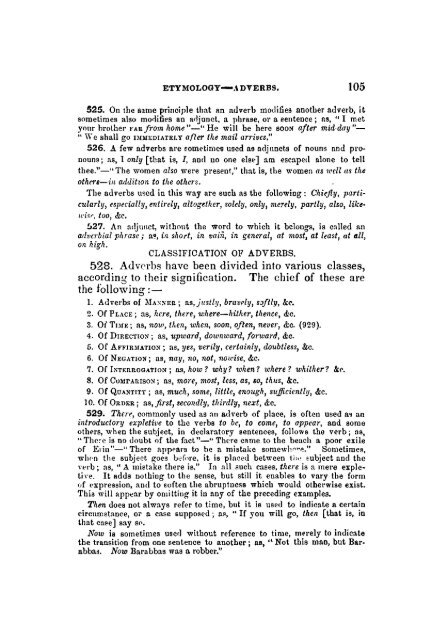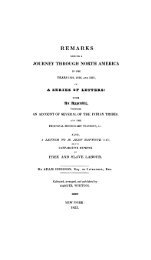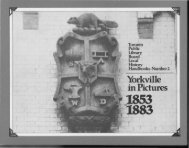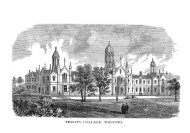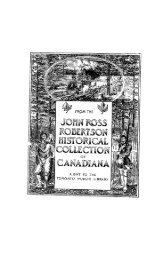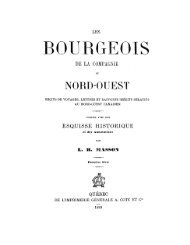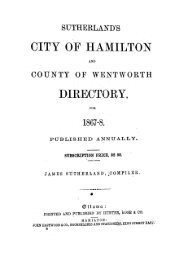alytical practical grammar - Toronto Public Library
alytical practical grammar - Toronto Public Library
alytical practical grammar - Toronto Public Library
You also want an ePaper? Increase the reach of your titles
YUMPU automatically turns print PDFs into web optimized ePapers that Google loves.
ETYMOLOGY-.\ DVERBS. 105<br />
525. On the same principle that an adverb modifies another adverb, it<br />
sometimes also moclifies an acljuDct, a phrase, 01' a eentence; as, "I met<br />
yonr hrother FAR from home "_," He will be here SOON after mid·day"<br />
.. \Ve shall go HIMEDIATEI.Y after the mail an'ives,"<br />
526. A few adverbs are wmetimes used as adjnncts of nouns and pro·<br />
nouns; as, I only [that is, I, and uo one else] am escaped alone to tell<br />
tbee."-" The women also were present," that is, the women as well as the<br />
others-in additIOn to the others.<br />
The adverbs uscd in this way are such as the following: Chirjly, parti·<br />
cularly, especially, erltirely, altogether, solely, only, merely, partly, also, Wee·<br />
,cisc, too, &c.<br />
527. An adjunct, without the word to which it belongs, is called an<br />
adverbial phrase; a~, in short, in vain, in general, at most, at least, at all,<br />
on high.<br />
CLASSIFICA TION OF ADVERBS.<br />
528. Adverbs havc becn divided into various classes,<br />
according to their signification. The chief of these are<br />
the following :-<br />
1. Adverbs of ~fA:-;);EIl; as,justly, bravply, s:Jftly, &('.<br />
2. Of PLACE; as, here, there, where-hither, thtnee, &c.<br />
3. Oi TIME; as, noUl, tAen, when, soon, often, never, &c, (929).<br />
4. Of DIRECTIO);; as, upward, downward, forward, &c.<br />
5. Of AFFIR1IATlON; as, yes, verily, eel·tainly, doubtless, &c.<br />
6. Of NEGATION; as, nay, no, not, nowise, &c.<br />
7. Of h'TERROGATION; as, how? why? when? where? whither? &~.<br />
8. Of COMrAIlISO);; as, more, most, less, as, so, thus, &c.<br />
9. or QUA);TITl'; as, much, some, little, enough, sufficiently, &c.<br />
10. Of ORDER; as, first, secondly, thirdly, next, &c.<br />
529. There, commonly used as an adverb of place, is often used a9 an<br />
introductory expletive to the verbs to be, to come, to appear, and some<br />
others, when the subject, in declaratory sentences, follows the verb; 3S,<br />
"The~e is no doubt of the fact "-" There came to the beach a poor exile<br />
of Edn "-" Therc appears to he a mistake somewho"p.." Sometimes,<br />
whf'n the subject goes before. it is placed between Ii:., .ubject and the<br />
verb; as, " .A. mistake there is." In nil such cases, there is a mere expletiye.<br />
It adds nothing to the sense, but still it enables to vary the form<br />
of expression, and to soften the abruptness which would otherwise exist.<br />
This will app .. ar by omitting it in any of the preceding examples.<br />
Then does not always refer to time, but it is used to indicate a certain<br />
circumstance, or a case supposed; as, "If you will go, thell [that is, in<br />
that case] say SQ.<br />
Now is sometimes user! without reference to time, mHely to indicate<br />
the transition from one sentence to another; as, .. Not this man, but Bar.<br />
abbas. Now Barabbas was n robber."


